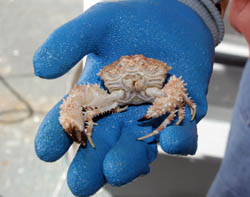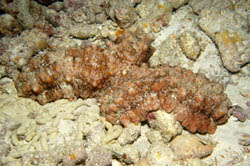New
Species
With all the taxonomic firepower on this expedition, as well as the diversity of collection methods employed, it was expected that we would find many new species records for French Frigate Shoals, and possibly new species. After only the second day of operations it appears that we are on track to fulfill that expectation. The scientists have found several organisms that may be new species, and several that are likely new records for the area.
Click
here to view New Species and New Records!
 |
This sea cucumber, Holothuria sp. has been observed before but not fully described. It may be a new species. Photo: Gustav Paulay. |
It was unclear to me until just a few minutes ago what a “new species” really means. There are species that have been observed, and even recorded in popular literature, but until they have been fully researched (using collections, existing descriptions, photos, etc.) to eliminate matches with any known species, then described, and then this description published in a peer reviewed science journal, only then can they be given a full scientific name and considered a new species. You may see species names that have a genus, but only a sp. for the species name, or a cf. between the genus and species name. These are species that have been observed, and may even be described, but the description has not been published, and thus it cannot be confirmed that the species is completely new. It may very well exist somewhere else, and the scientific review process is the way to validate this. There are other “new species” that have never been described or observed anywhere, and these too will need to go through the same process before they can be confirmed as new species and get scientific names. A “new record” is a species that is known from somewhere else, but has never been observed in the area of inspection, and thus is a new species for the area but not a new species to science.
 |
This crab, Leucosiid
sp. may be a new species. Photo: Andy Collins. |
The reality of the practicing scientist is far from the general public view of
the person in the white lab coat making one startling new discovery after
another. Many scientists struggle their entire careers to make
one new discovery, and it usually involves extensive effort, patience and attention
to detail. Some work a lifetime to ultimately prove their hypothesis
wrong, which, from the scientific perspective, is just as valuable
when
done thoroughly, though certainly not as glorious. The scientific
process to prove or disprove an idea, or confirm a new species is an arduous
one, frequently taking years, and much debate. The time it
takes to confirm a new species is also dependant upon how many species there
are in the genus or family of that particular type of organism,
the larger the family or genus the more time it takes to confirm a new species,
since the new organism will have to be compared against a larger
number
of organisms. There are many checks and balances in the identification
system, and a seemingly endless process of review and discussion.
Ultimately the objective of this whole process is to exhaust all possible disagreement,
and authoritatively say that a new species has been found,
or a new
record observed.
 |
This sea cucumber, Stichopus
sp. has been observed before but not fully described. It may be a new species. Photo: Gustav Paulay. |
Fortunately for the scientists aboard this expedition, several who are experts
in their field, the marine
realm is not nearly as well studied as the terrestrial realm,
and remote areas such as French Frigate Shoals are like the
wild unknown frontier of
marine taxonomy. There are many limitations to studying an area
such as French Frigate Shoals. First, it is far from any populated
area (over 500
miles from Honolulu), with no public facilities and requires
a ship to get here. Second, it does not have an area protected
from weather, waves or
strong currents. Third, it is a large area, some 12 miles in
diameter. Fourth, survey time is limited by the amount of time
you can spend underwater breathing
compressed air, which is roughly two hours per day/per person
considering three dives at 60 feet. Fifth, it is a fully protected
marine area under
strict regulation by the U.S. Fish and Wildlife Service, NOAA,
and the State of Hawaii. I could go on...the weather is too
foul or the waves too big
during the winter to conduct dive operations, there are protected
species disturbances to consider, etc. For all these reasons
the area has not been
studied as extensively as the main Hawaiian Islands, or other
parts of the Pacific, and thus the probability to make new
discoveries is high. One final
factor that makes French Frigate Shoals a potential hot spot
of diversity in the Hawaiian Archipelago is that the area is
seen as possible gateway
for species recruiting to the archipelago from Johnston Atoll
to the south. The abundance of Acropora table corals at French
Frigate Shoals, and their
relative absence up and down the archipelago is commonly cited
as evidence of the connection to Johnston Atoll since table
corals are abundant there,
as they are in the rest of the South Pacific, but not in the
main Hawaiian Islands, or the atolls at western end of the
archipelago.
*All images and information from French Frigate Shoals are provided
courtesy of the Northwestern Hawaiian Islands Marine National Monument,
Hawaiian Islands National Wildlife Refuge, the Northwestern Hawaiian
Islands State Marine Refuge, and NOAA's Pacific Islands Fisheries
Science Center in accordance with permit numbers NWHIMNM-2006-015,
2006-01, 2006-017, and DLNR.NWHI06R021 and associated amendments.
Click
on one of the following areas to follow the expedition.
Ship
Logs:
Day-by-day
activities of the ship: what research is being done that
day, what the weather is like, what's for dinner, etc.
Journals:
Daily
or semi-daily personal journal entries by the particpants
in the expedition. These journals do not necessarily reflect
the positions of any of the agencies connected with this
project.
Interviews:
Interviews with expedition participants, scientists,
vessel crew, educators, etc.
Features:
Highlights or special information such as interesting
discoveries or related research.